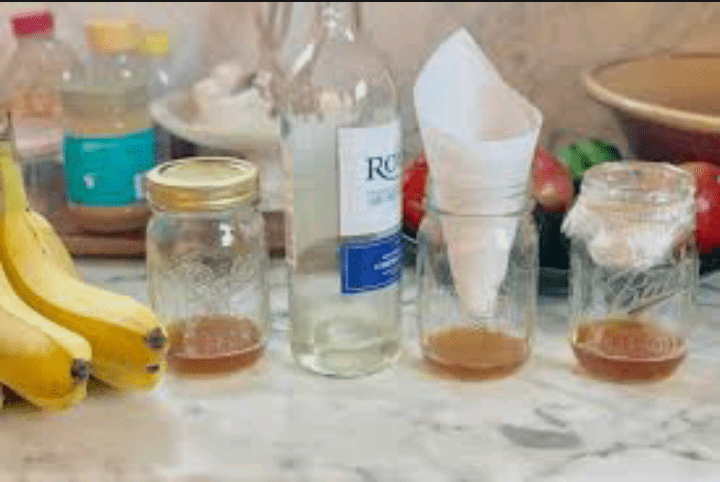Are you tired of those pesky little fruit flies buzzing around your kitchen, making a beeline for your fresh fruits and veggies? Fear not! A DIY fruit fly trap might just be the simple solution you need to bid farewell to these bothersome insects.
These tiny creatures have a knack for appearing out of nowhere, but with a few household items and a pinch of know-how, you can create an effective trap right in the comfort of your home.
Fruit flies seem to have a magical ability to multiply in the blink of an eye, but understanding their behavior is the first step to curbing their presence. They’re irresistibly drawn to overripe fruits, vegetables, and fermented liquids like vinegar.
Armed with this knowledge, we’ll guide you through the process of crafting a homemade fruit fly trap that efficiently lures and traps these pests, without the need for harsh chemicals or complicated equipment.
In this article, we’ll take you step-by-step through the creation of your very own fruit fly trap. From choosing the right bait to setting up and maintaining the trap, we’ll explore every aspect in simple, easy-to-follow instructions. The goal? To help you take back control of your kitchen and keep those fruit-loving flies at bay.
By following these straightforward methods, you’ll not only manage to trap these flying nuisances but also contribute to a cleaner and more pleasant living environment. So, grab a few items lying around your house and let’s dive into the world of DIY fruit fly traps—your key to a fruit fly-free zone!
Read Also: FFXIV Fashion Report – All You Need to Know About
DIY Fruit Fly Trap

1. Understanding Fruit Flies
Before going into the trap-making process, it’s crucial to understand your tiny foes. Fruit flies are attracted to decaying organic matter, particularly ripe or rotting fruits and vegetables, as well as fermented liquids like vinegar or wine. These insects lay their eggs near these food sources, and within days, their population can surge.
2. The DIY Fruit Fly Trap Components
To assemble your homemade fruit fly trap, you’ll need a few basic items:
i. A Container: Any small container with a wide mouth will do—think a glass jar, a plastic bottle, or a disposable cup. Ensure the opening is wide enough for the flies to enter but not too wide for them to easily escape.
ii. Fruit Fly Bait: Choose a bait that fruit flies find irresistible. Apple cider vinegar, ripe fruit slices, or a piece of overripe banana work wonders. The strong smell will lure the flies into the trap.
iii. Liquid Dish Soap: A few drops of dish soap help break the surface tension of the liquid, causing the flies to sink and drown once they land on it.
iv. Plastic Wrap or Paper: To create a cover with small holes for entry.
Read Also: DIY Meaning: Unveiling the Power of Do It Yourself
3. Step-by-Step Guide
Now, let’s walk through the process of crafting your own DIY fruit fly trap:
Step 1: Prepare the Container: Take your chosen container and fill it about one-third to halfway with the fruit fly bait of your choice. Ensure the bait is at room temperature for maximum fragrance release.
Step 2: Add Dish Soap: Squirt a few drops of liquid dish soap into the bait. The soap reduces the surface tension of the liquid, making it difficult for the flies to land and fly away, causing them to drown instead.
Step 3: Cover the Container: Take a piece of plastic wrap or paper and cover the container, securing it tightly with a rubber band or string. If using plastic wrap, poke small holes in it using a toothpick or a fork—these holes will serve as entry points for the fruit flies.
Step 4: Placement: Place the trap in areas where fruit flies are frequently seen. Kitchens, near garbage bins, and close to fruit bowls are prime locations.
Step 5: Monitor and Replace: Regularly monitor the trap. Once it’s full of flies or the bait loses its potency, dispose of the contents in a sealed bag and refill with fresh bait and soapy water.
4. Tips for Maximum Effectiveness
i. Optimal Placement: Fruit flies are most active during the day, so position the trap in a well-lit area. They are also attracted to warm places, so consider placing the trap near a light source.
ii. Regular Maintenance: Cleaning the trap and refreshing the bait regularly will ensure its effectiveness in trapping the flies.
iii. Experiment with Bait: If one type of bait doesn’t seem to work, experiment with other options. Some flies might have preferences for certain fruits or liquids.
Read Also: Air Pollution and Different Types of Air Pollution
